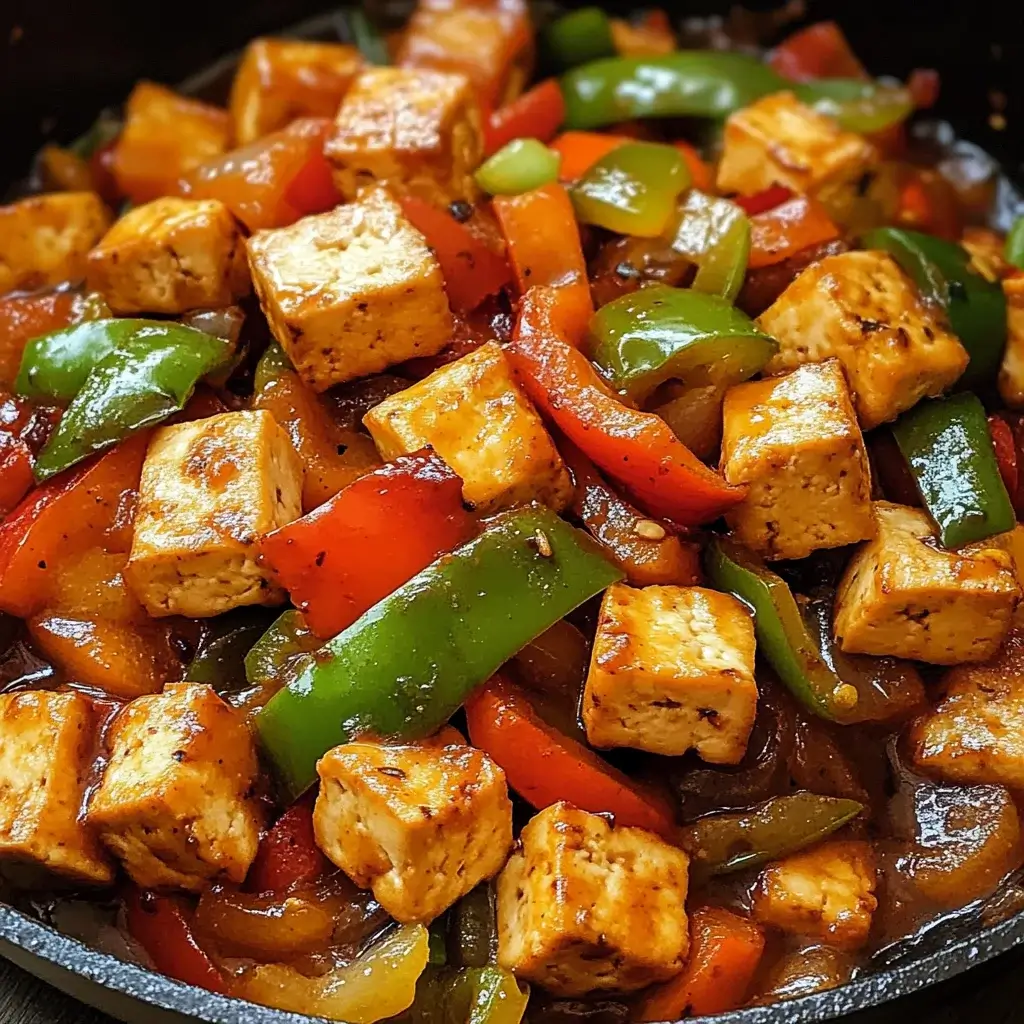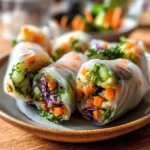This Tofu and Bell Pepper Skillet has genuinely transformed our weeknight dinner routine. For the longest time, I struggled to find a meal that was quick to whip up after a long day, packed with nutrients, and, most importantly, something the whole family would actually eat without complaints. Tofu used to get a mixed reception in our house – until this recipe came along! The combination of crispy-edged tofu, vibrant, sweet bell peppers, and a savory, slightly tangy sauce is just a winner. The first time I made it, the aroma alone had everyone drifting into the kitchen. My partner, who was previously a tofu skeptic, now requests it, and even the kids enjoy picking out their favorite colored peppers. It’s become our go-to for a reason: it’s incredibly versatile, forgiving if you want to swap in different veggies, and it leaves you feeling satisfied but not overly full. Plus, clean-up is a breeze with it being a one-skillet wonder!
Ingredients
- 1 (14-16 ounce) block extra-firm tofu: Pressed for at least 30 minutes and patted dry, then cut into 1-inch cubes. This ensures the tofu gets wonderfully crispy.
- 1 tablespoon cornstarch (or arrowroot starch): For coating the tofu, helping it achieve a golden, crispy exterior.
- 2 tablespoons olive oil (or avocado oil): Divided; for pan-frying the tofu and sautéing the vegetables.
- 1 large red bell pepper: Cored, seeded, and sliced into thin strips. Adds sweetness and vibrant color.
- 1 large yellow bell pepper: Cored, seeded, and sliced into thin strips. Offers a milder sweetness and another pop of color.
- 1 large green bell pepper (or orange): Cored, seeded, and sliced into thin strips. Provides a slightly more savory note and completes the rainbow.
- 1 medium yellow onion: Thinly sliced. Forms the aromatic base of the dish.
- 3 cloves garlic: Minced. For that essential aromatic kick.
- 1-inch piece of fresh ginger: Grated or finely minced. Adds warmth and a zesty fragrance.
- For the Sauce:
- 1/4 cup low-sodium soy sauce (or tamari for gluten-free): The primary savory and umami component.
- 2 tablespoons rice vinegar: Adds a pleasant tanginess that brightens the flavors.
- 1 tablespoon maple syrup (or agave nectar): For a touch of sweetness to balance the savory and tangy notes.
- 1 tablespoon toasted sesame oil: Imparts a rich, nutty aroma and flavor.
- 1 teaspoon sriracha or chili garlic sauce (optional): For a hint of spice, adjust to your preference.
- 1 tablespoon water (or vegetable broth): To help create the right consistency for the sauce.
- Optional Garnishes:
- Toasted sesame seeds: For crunch and nutty flavor.
- Freshly chopped cilantro or green onions: For a burst of freshness and color.
Instructions
- Prepare the Tofu:
- If you haven’t already, press your block of extra-firm tofu. You can use a tofu press or wrap the tofu in several layers of paper towels or a clean kitchen towel, place it on a plate, and put something heavy on top (like a few cookbooks or a cast iron skillet) for at least 30 minutes. The longer you press, the firmer and crispier your tofu will be.
- Once pressed, pat the tofu block thoroughly dry with more paper towels. Cut it into 1-inch cubes.
- In a medium bowl, gently toss the tofu cubes with the 1 tablespoon of cornstarch until they are lightly and evenly coated. This step is crucial for achieving that desirable crispy exterior. Set aside.
- Mix the Sauce:
- In a small bowl, whisk together all the sauce ingredients: low-sodium soy sauce (or tamari), rice vinegar, maple syrup (or agave), toasted sesame oil, sriracha (if using), and water (or vegetable broth).
- Stir well until the maple syrup is fully dissolved and everything is well combined. Taste and adjust seasonings if needed – you might want a little more sweetness, tang, or spice. Set aside.
- Cook the Tofu:
- Heat 1 tablespoon of olive oil (or avocado oil) in a large skillet or wok over medium-high heat. The oil should be hot enough that a piece of tofu sizzles gently when added.
- Carefully add the cornstarch-coated tofu cubes to the hot skillet in a single layer. Be sure not to overcrowd the pan; cook in two batches if necessary. Overcrowding will steam the tofu instead of crisping it.
- Cook the tofu for about 4-5 minutes per side, turning occasionally with tongs or a spatula, until all sides are golden brown and crispy. This might take around 10-15 minutes in total.
- Once the tofu is beautifully browned and crisp, remove it from the skillet using a slotted spoon and transfer it to a plate. You can line the plate with a paper towel to absorb any excess oil if you wish.
- Sauté the Aromatics and Vegetables:
- To the same skillet (no need to wipe it clean, those browned bits add flavor!), add the remaining 1 tablespoon of olive oil. If the skillet seems dry, you can add a little more.
- Add the thinly sliced yellow onion to the skillet and sauté over medium heat for about 3-4 minutes, or until it begins to soften and become translucent.
- Stir in the minced garlic and grated ginger. Cook for another minute until fragrant, being careful not to burn the garlic. The aroma at this stage is incredible!
- Add all the sliced bell peppers (red, yellow, and green/orange) to the skillet. Increase the heat slightly to medium-high and continue to sauté, stirring frequently, for about 5-7 minutes. You want the peppers to be tender-crisp – softened but still retaining a bit of a bite and their vibrant color. Avoid overcooking them into mush.
- Combine and Simmer:
- Return the cooked, crispy tofu cubes to the skillet with the sautéed vegetables.
- Give the prepared sauce a quick whisk again (as some ingredients might have settled) and pour it evenly over the tofu and vegetables in the skillet.
- Gently toss everything together to ensure the tofu and vegetables are well coated with the sauce.
- Allow the mixture to simmer for 2-3 minutes, stirring occasionally. This allows the sauce to thicken slightly and the flavors to meld together beautifully. The heat will help the sauce cling to every nook and cranny.
- Serve:
- Once the sauce has thickened to your liking and everything is heated through, remove the skillet from the heat.
- Serve the Tofu and Bell Pepper Skillet hot. Garnish with toasted sesame seeds and freshly chopped cilantro or green onions, if desired, for an extra layer of flavor, texture, and visual appeal.
Nutrition Facts
- Servings: 4
- Calories per serving: Approximately 350-400 calories (this can vary based on exact ingredient brands and oil usage)
- Protein: Around 20-25g per serving. Tofu is an excellent source of complete plant-based protein, crucial for muscle repair, satiety, and overall bodily functions.
- Fiber: Approximately 6-8g per serving. Bell peppers, onions, and tofu contribute to the fiber content, aiding digestion and promoting fullness.
- Vitamin C: High. Bell peppers, especially red and yellow ones, are packed with Vitamin C, a powerful antioxidant that supports immune function.
- Iron: Good source. Tofu provides plant-based iron, important for oxygen transport in the blood and preventing fatigue.
- Healthy Fats: Contains monounsaturated and polyunsaturated fats from olive oil and sesame oil, beneficial for heart health.
Preparation Time
- Active Preparation Time: Approximately 20-25 minutes (includes pressing tofu if done concurrently, chopping vegetables, mixing sauce).
- Cook Time: Approximately 20-25 minutes.
- Total Time: Approximately 40-50 minutes (plus at least 30 minutes for pressing tofu, which can be done passively). This recipe is designed for weeknight efficiency, offering a flavorful and nutritious meal without spending hours in the kitchen.
How to Serve
This Tofu and Bell Pepper Skillet is wonderfully versatile. Here are some delicious ways to serve it:
- Over Grains:
- Fluffy Rice: Serve atop a bed of steamed white rice (Jasmine or Basmati work beautifully), brown rice for extra fiber, or even quinoa for a protein boost. The grains soak up the delicious sauce perfectly.
- Quinoa: A complete protein itself, quinoa adds a nutty flavor and slightly chewy texture, making the meal even more filling and nutritious.
- Couscous or Farro: These grains offer different textures and can provide a delightful change of pace.
- With Noodles:
- Rice Noodles: Transform it into a quick noodle bowl by serving over cooked rice noodles (Pad Thai style or vermicelli).
- Soba Noodles: The earthy flavor of buckwheat soba noodles complements the savory sauce well.
- Lo Mein or Ramen Noodles: For a heartier noodle dish.
- In Wraps or Lettuce Cups:
- Tortillas: Spoon the mixture into warm tortillas (corn or flour) for a tasty tofu and veggie taco or fajita-style meal. Add a dollop of avocado or salsa.
- Lettuce Wraps: For a lighter, low-carb option, serve the skillet mixture in crisp lettuce cups (like butter lettuce or romaine hearts).
- As a Standalone Dish:
- Enjoy it on its own for a satisfying, low-carb, and vegetable-rich meal.
- Alongside Other Dishes:
- Serve as a vibrant side dish to a larger Asian-inspired spread.
- Pair with a simple miso soup or a fresh cucumber salad.
- Toppings and Enhancements:
- A drizzle of extra sriracha or chili oil for more heat.
- A sprinkle of crushed peanuts or cashews for added crunch.
- A wedge of lime for a fresh citrusy squeeze.
Additional Tips
- Press Your Tofu Thoroughly: This is non-negotiable for crispy tofu. Excess water prevents browning and results in a softer, more crumbly texture. Invest in a tofu press or use the weighted plate method for at least 30 minutes, or even up to a few hours in the fridge.
- Don’t Skip the Cornstarch: The light coating of cornstarch (or arrowroot starch) is a secret weapon for an extra crispy tofu exterior that holds up well to the sauce. Ensure the tofu is patted dry before tossing with starch for best adhesion.
- High Heat for Searing: When cooking the tofu and stir-frying the vegetables, ensure your pan and oil are sufficiently hot. This allows for a quick sear, developing flavor (Maillard reaction) and preventing the ingredients from becoming soggy.
- Avoid Overcrowding the Pan: Whether cooking tofu or vegetables, cook in batches if necessary. Overcrowding lowers the pan’s temperature, leading to steaming rather than searing or sautéing. This is especially critical for crispy tofu.
- Customize Your Vegetables: Feel free to swap or add other vegetables based on what you have on hand or prefer. Broccoli florets, snap peas, mushrooms (shiitake or cremini), carrots (julienned), or bok choy would all be delicious additions. Adjust cooking times accordingly.
- Taste and Adjust the Sauce: The provided sauce recipe is a great starting point, but don’t be afraid to tweak it to your liking. Want it spicier? Add more sriracha. Sweeter? A bit more maple syrup. Tangier? A splash more rice vinegar.
- Prep Ahead for Quicker Assembly: To make this meal even faster on a busy night, you can press the tofu, chop all the vegetables, and whisk together the sauce ingredients a day in advance. Store them in separate airtight containers in the refrigerator.
- Toasted Sesame Oil as a Finisher: While a little can be used in the sauce, adding a small drizzle of toasted sesame oil just before serving enhances its nutty aroma and flavor significantly, as its delicate compounds are best preserved with minimal cooking.
FAQ Section
- Q: Can I use frozen tofu for this recipe?
A: Yes, you can! Freezing and thawing tofu changes its texture, making it chewier and more porous, which can be great for absorbing marinades and sauces. Thaw the tofu completely, then press it very well, as it will release even more water than fresh tofu. Proceed with cubing and coating in cornstarch as directed. - Q: How do I make this recipe gluten-free?
A: It’s very simple! Just ensure you use tamari instead of regular soy sauce, as tamari is typically brewed without wheat. Also, double-check that your cornstarch (or arrowroot starch) is certified gluten-free if you have celiac disease or a severe sensitivity. All other core ingredients are naturally gluten-free. - Q: My tofu never gets crispy. What am I doing wrong?
A: The most common culprits are insufficient pressing, skipping the cornstarch, using too low heat, or overcrowding the pan. Ensure your tofu is pressed very well to remove excess moisture. The cornstarch creates a dry surface that crisps up. Use medium-high heat so the oil is hot enough to sear, and cook the tofu in a single layer, in batches if needed, to maintain that heat. - Q: Can I marinate the tofu before cooking?
A: Absolutely! Marinating can add extra flavor. After pressing and cubing the tofu, you can marinate it in a portion of the sauce (or a separate simple soy-ginger marinade) for at least 30 minutes or even overnight. Pat it dry before tossing with cornstarch to ensure it still crisps up. - Q: What other vegetables work well in this skillet?
A: This recipe is highly adaptable! Try adding broccoli florets, snap peas, snow peas, sliced mushrooms (shiitake, cremini, or button), julienned carrots, baby corn, water chestnuts, or even leafy greens like spinach or bok choy (add these towards the very end of cooking as they wilt quickly). - Q: How do I store and reheat leftovers?
A: Store any leftovers in an airtight container in the refrigerator for up to 3-4 days. To reheat, you can gently warm it in a skillet over medium heat with a splash of water or broth to prevent drying out, or microwave it until heated through. The tofu may lose some of its initial crispiness upon reheating but will still be delicious. - Q: Can I make this dish spicier or milder?
A: Yes! To make it spicier, increase the amount of sriracha or chili garlic sauce. You could also add a pinch of red pepper flakes with the garlic and ginger. For a milder version, simply omit the sriracha or use a very small amount. You can also use a sweet chili sauce for flavor without intense heat. - Q: Is this Tofu and Bell Pepper Skillet vegan?
A: Yes, as written, this recipe is entirely vegan and plant-based. It uses no animal products. If you use maple syrup instead of honey (which is sometimes debated in vegan circles, though maple syrup is a safe bet), it fits all vegan criteria.






